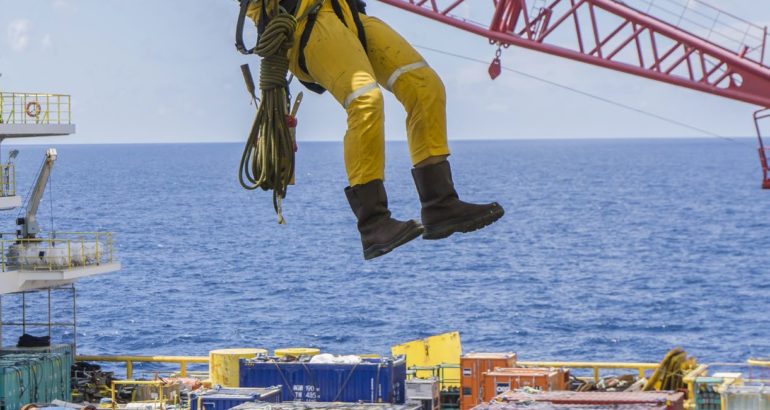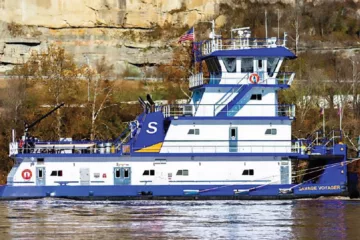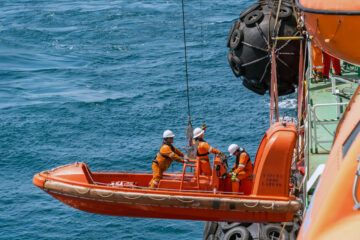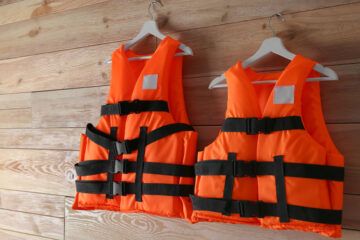When a person is working at heights as one generally may encounter when involved in virtually any form of marine construction and is using fall protection equipment, he/she may require rescue if that person falls and suddenly finds oneself suspended in a harness. Prompt rescue is very important. Studies indicate that a person suspended in a harness may have blood circulation problems within a few minutes. Accordingly, a site-specific “Rescue Plan” must be prepared in writing and maintained for all instances where personnel work at heights and are exposed to fall hazards.
The “Rescue Plan” should generally contain detailed procedures on the methods of rescue; methods of self-rescue; equipment used; training requirements; specialized training for the rescuer; procedures for requesting the rescue; and available medical assistance. Where the rescue may not be or cannot be solely performed by a jurisdictional public, e.g. city or municipal fire department, Coast Guard and/or any “Paramedic Type Emergency Response Agency then the “Rescue Plan” must contain detailed procedures on the planned rescue methods.
The “Rescue Plan” is a part of the written “Fall Protection and Prevention Plan” and contains provisions for potential self-rescue or assisted rescue of an end user of fall protection. The “Fall Protection and Prevention Plan” should cover every potential fall hazard to which authorized persons are exposed to.
Another important document is the “Pre-Incident Plan”. A “Pre-Incident Plan” is a formal written plan prepared jointly by the Contractor and any available emergency responders containing factors that need to be evaluated when assessing the potential situations, e.g. fuel storage tanks, energized power cables, hazardous material, cranes, hoists/winches or any barge mounted equipment or materials that may present a hazard that could affect a given situation during an emergency condition.
The “Pre-Incident Plan” is prepared, reviewed, updated, and approved by a competent person. The fall protection program manager from the activity reviews and concurs with the portion of “Pre-Incident Plan”, which addresses rescuing a person who has fallen and is suspended in a harness and incorporates this information into the “Rescue Plan”.
Following a fall from a height the end user of fall protection, who is wearing a body harness that is properly secured to an anchorage, may be suspended in the harness for a length-of-time if self-rescue or rescue by co-workers cannot be performed quickly.
Sustained immobility in a body harness may lead to suspension trauma also known as harness induced pathology as described in reference (a). Suspension trauma resulting from the accumulation of blood in the veins commonly called venous pooling. The symptoms (known as orthostatic intolerance) of suspension trauma include lightheadedness, dizziness, weakness and occasionally fainting.
Normally when an individual faints and collapses, the pooled blood is now no longer being held down by gravity and returns to the heart, where it is once again distributed to the body. Assuming no injuries are caused during the collapse, the individual will quickly regain consciousness and recovery is likely to be rapid.
When an individual hangs in a harness in a vertical or near vertical position without moving his legs, the same thing can happen; only this time when he passes out he remains vertical. An accumulation of blood in the legs reduces the amount of blood in circulation. After an initial speeding up of the heartbeat, the heart rate then slows down and blood pressure will diminish in the arteries. The reduction in quantity and/or quality (oxygen content) of blood flowing to the brain leads to unconsciousness and harmful effects on other vital organs. If these conditions continue, they potentially may be fatal.
As one can see…the importance of a timely rescue of a worker suspended in a harness or who has become incapacitated due to an injury and/or heart attack mandates the need for a written rescue plan.









